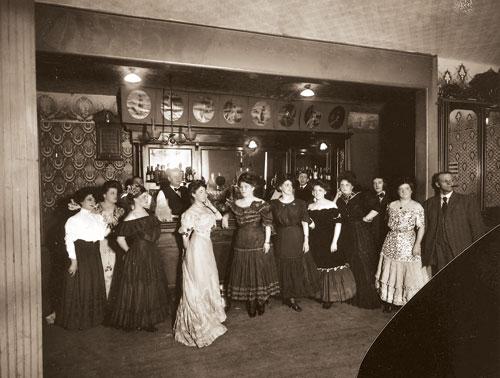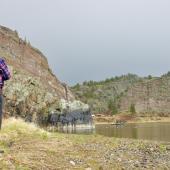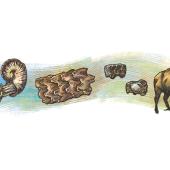Tycoons in Petticoats
Frontier Montana's Uncommon Red Light Madams...
Untamed, undefined, and unconventional, the Montana frontier was a land of opportunity and promise, not only for men, but surprisingly, also for some assertive women. Nowhere was this more obvious than in the complicated and interesting world of prostitution. Here, for a few, brief decades during the late nineteenth and early twentieth centuries, a colorful cadre of strong-willed madams shattered social conventions, overcame significant obstacles, and temporarily redefined the complex economic, political, and social dynamics of a fluid and still-formulating land.
In contrast to the one-dimensional stereotypes found in spaghetti westerns and dime store novels, the real lives of Montana’s prostitutes were remarkably diverse and delightfully unexpected. As historian Mary Murphy and others have observed, the skin trade was a highly stratified and blatantly public profession. Individual qualities, such as race, ethnicity, education, and sexual skill, determined each woman’s status, which was most obviously reflected in the place she worked. For many, the life was unquestionably tragic and frequently tainted by addiction, abuse, and degradation. For a lucky few, however, prostitution became an alternative—a means of sidestepping the limitations of traditional gender roles and boldly challenging an irrational world that offered few real possibilities for wage-earning women.

Typical western towns of the late nineteenth century had many more men than women, and prostitutes were common sights throughout frontier Montana. Research by historian Robert Schick, for example, suggests that there were perhaps 50,000 ladies of the evening working in the trans-Mississippi West during the late 1800s. Often they were young—usually in there twenties—geographically mobile, and native born. As might be expected, most engaged in sexual commerce out of economic necessity, and remained so for only a limited period of time before transitioning into another chapter in their lives.
Many Victorian townsfolk, while repulsed by prostitution, nonetheless considered it an unavoidable evil. Because it was only a misdemeanor throughout Montana prior to World War I, local authorities simply sought to confine the practice in geographically distinct red light districts or tenderloins that were physically segregated from more decent neighborhoods. There, public health officials kept an eye on things, and the police gathered monthly fines, which made significant contributions to civic coffers.
While no comprehensive study of prostitution in Montana currently exists, an analysis of three Montana communities—Helena, Bozeman, and Butte—clearly reveals that a handful of memorable tycoons in petticoats found financial security, owned extensive property, and successfully navigated between social classes through less than reputable means.
With the discoveries of tremendous gold reserves at Last Chance Gulch in the mid-1860s, Helena, Montana, rapidly assumed a distinctive character. By 1874, it had outgrown its mining camp persona and replaced Virginia City as the bureaucratic and economic capital of Territorial Montana.
Mirroring Helena’s prosperous aura was its extensive red light district, which flourished between Wood and Bridge Streets. Initially, a number of “proprietor prostitutes” working alone out of small houses that they owned, defined the district. By the 1880s, however, a few increasingly powerful madams consolidated ownership of the tenderloin, erecting several large parlors and colorful bawdy houses. By the 1886, no less than fifty-two white prostitutes worked in Helena’s demimonde, which for more than twenty years had constituted the town’s largest single source of women’s employment outside of the home.
One of the most prominent madams in Helena during this time was Josephine Airey “Chicago Joe” Hensley who, beginning in 1871, shrewdly manipulated a series of business deals to become “the queen of the city’s red light district.” Mortgaging everything, including “three dozen pair of underclothes,” she rapidly became the largest landowner on Wood Street. At the peak of her success, Chicago Joe had invested more than $30,000 to erect the Coliseum, a vaudevillian variety theater, and other sizable building projects. But the nationwide Panic of 1893 found her financially overextended, and virtually all of her property ultimately transferred to others. She died of pneumonia a few years later at the age of fifty-six.
Mollie “Crazy Belle Crafton” Byrnes was another significant player in Helena’s red light district. Born in New Orleans, Byrnes settled in Helena in 1881 and set up operations in the heart of the demimonde. By May of 1884, she secured the old Kiyus Saloon property, while renting several other residential properties in other parts of the city. Two years later she financed the construction of a grand, $12,000 bordello that soon became known as “the castle.” By 1899, Byrnes sold her flagship property to a local hotel owner. When she died of acute alcoholism a year later, her estate was valued at $20,000 cash in real and personal property.
Another successful Helena prostitute was Louisa Couselle who, like Hensley and Byrnes, regularly bought and sold property while extending mortgages to others. Sensing opportunity in uncharted waters, Couselle soon relocated to Bozeman, where competition was virtually non-existent. With impressive financial resources at her disposal, Couselle purchased a total of fifteen lots, laying the foundation for a rapidly-growing tenderloin that would flourish one half block north of Main Street between North Rouse and North Bozeman Avenues. By 1875, the prosperous madam was extending mortgages to a wide range of residents including Kitty “Roberta Warn” Warren, a former employee also seeking to establish herself in town. With Couselle’s support, Warren purchased multiple properties in the same area as her patron, setting up yet another bordello, and broadening the perimeters of Bozeman’s now-thriving red light district. There, a steady supply of saloon, dance hall, and transient hotel patrons—most notably visiting soldiers from neighboring Fort Ellis—were regularly serviced.
The enterprise was very profitable, and by 1878, Couselle was of greater economic means than roughly ninety-five percent of Bozeman’s citizens. Her stature was so impressive that The Avant Courier Annual Almanac listed her as one of the fifty-nine “heavy taxpayers of Gallatin County.”
In the decade that followed, Couselle and Warren died with a year of one another–Warren at the age of twenty-five in 1885 from burns suffered in an accident and Couselle, the following year, at the age of fifty-four. The latter left an impressive estate valued at $20,000. Her obituary noted: “It is not necessary for us to describe her calling, or occupation, but that she was a remarkable women in many respects cannot and will not be gainsaid by anyone who knew her.”
Despite the passing these groundbreaking women, Bozeman’s den of iniquity continued to grow. Sanborn Fire Insurance maps from 1889 show no less than five “female-boarding” establishments in the concentrated district. Another six adjacent buildings were labeled as “Chinese,” and according to police records, harbored prostitutes as well as opium dens, some of which were secretly located underground. Although violence and debauchery were commonplace, and morally upstanding residents increasingly protested, the district expanded to nine “female-boarding” houses by 1904.
More than lining the pockets of a few prosperous madams, vice was also big business for the City of Bozeman. After 1898, Mayor J. V. Bogert collected monthly fines from as many as eighteen local prostitutes. Successful madams like Lizzie Woods, who operated a large brothel on East Mendenhall Street, paid a premium price to remain in business—ten dollars a month. Revenues generated from this system helped justify the continuation of the red light district well into the early twentieth century.
The 1904 completion of the town’s stately Carnegie Library directly across North Bozeman Avenue from the district brought pronounced pressure on officials to clean up the neighborhood. Affluent and socially conscious members of the Women’s Christian Temperance Union wrote newspaper editorials, complaining vehemently that their innocent youngsters had to walk in close proximity to such decadence in order to patronize the new facility. Despite these concerns, it would take nearly thirteen more years for Bozeman’s thriving red light district to finally shut down.
Of all the Montana towns touched by prostitution, however, Butte was arguably the most notorious. Between 1878, when its first hurdy-gurdy house opened, and 1917, when its red light district “officially” closed, Montana’s Mining City was home to hundreds—perhaps thousands—of prostitutes. Most lived and worked in a one-block area where virtually any vice was available, as long as the price was right. In 1905 evangelist William Biederwolf publicly proclaimed that Butte was the “lowest sinkhole of vice in the West.” There was, he thundered, “enough legitimate vice in Butte to damn the souls of every young man and young woman in it.”
While the vast majority of prostitutes employed on the “richest hill on earth” were “every night workingman’s whores,” who lived and worked in the cribs lining the streets and alleys of Butte’s tenderloin, small numbers were private mistresses who served clients in large high class parlor houses. Especially successful after 1900 was Lou Harpell, who managed the Hotel Victoria at 11 East Mercury. Harpell’s employees were “said to have been among the most beautiful women in the world,” according to historian Ellen Baumler. Harpell’s house was so highly respected, that during a 1903 roundup of red light district prostitutes, her employees were allowed to post bail at the house, rather than suffer the public humiliation of appearing in the City Court.
Another of Butte’s finer houses of prostitution was the Windsor Hotel at 9 East Mercury, which featured twenty-four beautifully appointed rooms with satin-covered sofas and chairs, gilt-framed mirrors, tapestries, and plants in brass jardinières. Oak and mahogany graced the bedrooms on the upper floors, which, in 1900, housed eight women and thirty-nine year-old madam Bertha Leslie.
Eventually renamed the Irish World, this impressive house of ill repute was later run by the infamous May Maloy, who gained notoriety in January of 1910, when she vigorously attacked the crusading 64-year-old Christian reformer Carrie Nation. The hatchet-wielding Nation, who was well-known nationally for entering bars and houses of prostitution in order to chastise the patrons and smash bottles of alcohol, was touring Butte’s red light district with a handful of other do-gooders from the Women’s Christian Temperance Union and the Salvation Army. Upon seeing Nation and a large crowd of spectators enter her thriving establishment, Maloy forcibly shoved the elderly Nation out of the Irish World, screaming:
“Get out of my place; get out of my place. Here, you policeman, put this woman out of here. I want these females who are raising a disturbance arrested and taken out of my house.”
Despite the efforts of Maloy and others to fend off a growing wave of Progressive Era improvements that swept across the United States, prostitution waned significantly in Montana after 1910. When Montana women gained the right to vote in 1914—a full six years before women nationwide—moral reform was prioritized like never before. Prohibition and anti-prostitution laws went hand in hand, and across the state, city officials dramatically increased the arrests of working girls and madams. By 1917, when Montana Attorney General Sam Ford called for the statewide crackdown on prostitution, most local districts of ill repute had nearly faded into oblivion. Only a few select locations, like Butte’s “Venus Alley” continued to operate well into the twentieth century.
A variety of factors made prostitution a thriving industry in Montana for several decades during the late nineteenth and early twentieth centuries. Demographic realities, Victorian attitudes toward sexuality, and the civic benefits of continuing red light districts all converged to elevate a very disreputable practice to the ranks of long-standing tradition in the Treasure State and throughout the American West.
But ultimately, perhaps one of the most significant causes for the flourishing of prostitution in Montana’s earliest decades were the prostitutes themselves. Ambitious, assertive, and uncommonly nonconformist, these strong-willed madams took no prisoners in their attempts to change social conventions and, thereby, define a strikingly non-traditional life for themselves. Their fascinating stories serve as important reminders that Montana’s colorful history is nothing if not unexpected.
~ Derek Strahn is a historic preservation consultant and history teacher at Bozeman High School. He lives in Bozeman with his wife and three children.












Leave a Comment Here